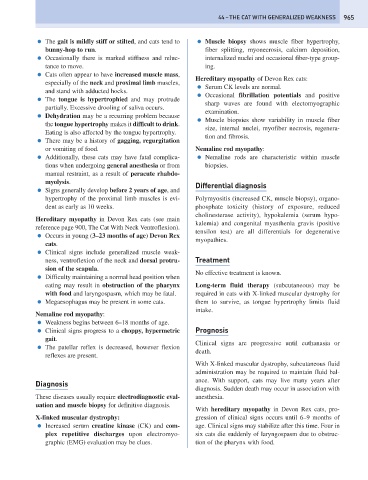Page 973 - Problem-Based Feline Medicine
P. 973
44 – THE CAT WITH GENERALIZED WEAKNESS 965
● The gait is mildly stiff or stilted, and cats tend to ● Muscle biopsy shows muscle fiber hypertrophy,
bunny-hop to run. fiber splitting, myonecrosis, calcium deposition,
● Occasionally there is marked stiffness and reluc- internalized nuclei and occasional fiber-type group-
tance to move. ing.
● Cats often appear to have increased muscle mass,
Hereditary myopathy of Devon Rex cats:
especially of the neck and proximal limb muscles,
● Serum CK levels are normal.
and stand with adducted hocks.
● Occasional fibrillation potentials and positive
● The tongue is hypertrophied and may protrude
sharp waves are found with electomyographic
partially. Excessive drooling of saliva occurs.
examination.
● Dehydration may be a recurring problem because
● Muscle biopsies show variability in muscle fiber
the tongue hypertrophy makes it difficult to drink.
size, internal nuclei, myofiber necrosis, regenera-
Eating is also affected by the tongue hypertrophy.
tion and fibrosis.
● There may be a history of gagging, regurgitation
or vomiting of food. Nemaline rod myopathy:
● Additionally, these cats may have fatal complica- ● Nemaline rods are characteristic within muscle
tions when undergoing general anesthesia or from biopsies.
manual restraint, as a result of peracute rhabdo-
myolysis.
Differential diagnosis
● Signs generally develop before 2 years of age, and
hypertrophy of the proximal limb muscles is evi- Polymyositis (increased CK, muscle biopsy), organo-
dent as early as 10 weeks. phosphate toxicity (history of exposure, reduced
cholinesterase activity), hypokalemia (serum hypo-
Hereditary myopathy in Devon Rex cats (see main
kalemia) and congenital myasthenia gravis (positive
reference page 900, The Cat With Neck Ventroflexion).
tensilon test) are all differentials for degenerative
● Occurs in young (3–23 months of age) Devon Rex
myopathies.
cats.
● Clinical signs include generalized muscle weak-
ness, ventroflexion of the neck and dorsal protru- Treatment
sion of the scapula.
No effective treatment is known.
● Difficulty maintaining a normal head position when
eating may result in obstruction of the pharynx Long-term fluid therapy (subcutaneous) may be
with food and laryngospasm, which may be fatal. required in cats with X-linked muscular dystrophy for
● Megaesophagus may be present in some cats. them to survive, as tongue hypertrophy limits fluid
intake.
Nemaline rod myopathy:
● Weakness begins between 6–18 months of age.
● Clinical signs progress to a choppy, hypermetric Prognosis
gait.
Clinical signs are progressive until euthanasia or
● The patellar reflex is decreased, however flexion
death.
reflexes are present.
With X-linked muscular dystrophy, subcutaneous fluid
administration may be required to maintain fluid bal-
ance. With support, cats may live many years after
Diagnosis
diagnosis. Sudden death may occur in association with
These diseases usually require electrodiagnostic eval- anesthesia.
uation and muscle biopsy for definitive diagnosis.
With hereditary myopathy in Devon Rex cats, pro-
X-linked muscular dystrophy: gression of clinical signs occurs until 6–9 months of
● Increased serum creatine kinase (CK) and com- age. Clinical signs may stabilize after this time. Four in
plex repetitive discharges upon electromyo- six cats die suddenly of laryngospasm due to obstruc-
graphic (EMG) evaluation may be clues. tion of the pharynx with food.

